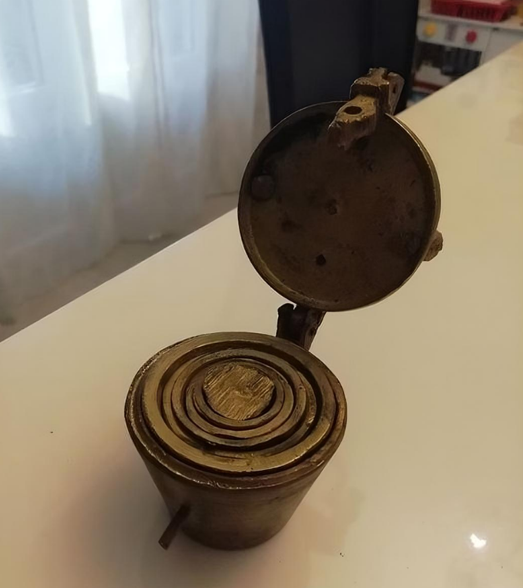Small brass cups that fit inside each other and latch closed might seem like a curious find at first glance. However, these objects have a rich historical background, revealing themselves as antique apothecary scale weight cups. Let’s dive into their origin, use, and why they hold such significance today.

What Are Apothecary Scale Weight Cups?
Apothecary scale weight cups were essential tools used by pharmacists, also known as apothecaries, during the 18th and 19th centuries. These cups were used for measuring precise amounts of ingredients required to create medicinal remedies. Before modern-day standardized measurements, accuracy in weighing ingredients was critical in preparing effective medications, and these brass cups played a key role in that process.
Historical Significance of Apothecary Scale Weight Cups
Apothecary scale weight cups carry a historical significance that extends beyond their functional use. During the 18th and 19th centuries, apothecaries were the equivalent of today’s pharmacists and chemists. They created medicinal concoctions from raw ingredients, and precision in measurement was essential to ensure both the safety and efficacy of their products.
Even a slight miscalculation in the quantity of an ingredient could affect the potency of a remedy or cause harm to patients. These brass cups helped apothecaries measure ingredients with exactness, reflecting the crucial role that accuracy played in early medical practices. They also provide insight into the evolving role of medical science and the emphasis placed on precision, a principle that remains central to pharmacy today.
Intricate Design and Craftsmanship
Apothecary scale weight cups are not just practical tools; they also showcase the craftsmanship of their era. Typically made from brass or other durable metals like bronze or copper, these cups were crafted with attention to detail. Many feature intricate designs or engravings, adding to their aesthetic appeal.
The cups usually come in a nested set, each cup representing a different weight. This design allowed apothecaries to use the appropriate cup depending on the amount of a specific ingredient they needed. The craftsmanship ranges from simple and utilitarian to more elaborate pieces, with some featuring delicate patterns or engravings that reflect the artistry of the time.
This blend of utility and beauty means that apothecary scale weight cups were valued not only for their function but also for their design, making them both practical tools and decorative pieces.
Durable Materials and Preservation
One of the reasons these apothecary scale weight cups have withstood the test of time is their construction from durable materials like brass, bronze, or copper. These metals ensured that the cups could handle regular use in an apothecary’s daily work. Over time, many of these cups develop a rich patina that enhances their antique charm, a quality that collectors often find appealing.
While they are built to last, proper care is essential for preservation. Today, collectors of antique apothecary tools and medical artifacts appreciate these cups for both their historical significance and aesthetic value. Their preservation provides a window into the careful methods of historical pharmacists.
Collecting Antique Apothecary Scale Weight Cups
Apothecary scale weight cups are highly sought after by collectors who specialize in medical antiques, vintage pharmacy tools, and scientific instruments. The value of these pieces can vary based on several factors, including their age, condition, craftsmanship, and rarity. Complete sets in good condition or those that feature unique markings or historical significance tend to command higher prices in the antique market.
For collectors, the allure of these cups lies not only in their historical context but also in their design. Each set tells a story of the evolution of pharmacy and the importance placed on precision in medicine. Whether you’re a history enthusiast or a medical professional, owning a set of these antique weight cups is like holding a piece of history in your hands.
Educational Value of Apothecary Weight Cups
Beyond their appeal to collectors, apothecary scale weight cups serve an educational purpose. They offer a tangible connection to the past, illustrating how far we have come in terms of medical technology and measurement standards. These artifacts highlight the importance of accuracy in early medicine and provide a glimpse into the meticulous practices of apothecaries of the time.
For educators and historians, these cups can serve as valuable teaching tools, helping students understand the challenges and innovations of historical pharmacy practices. They also showcase the evolution of medical knowledge and the ways in which tools and instruments have developed to meet the needs of advancing science.
The Symbolism of Apothecary Scale Weight Cups
While they may seem like simple brass objects, apothecary scale weight cups symbolize much more than their function. They represent a time when every aspect of medical practice required precision and care, where even the slightest miscalculation could have serious consequences. The cups are a testament to the attention to detail and the commitment to patient safety that apothecaries embodied, serving as a reminder of the vital role of precision in medicine.
As we look back at these weight cups, we can appreciate the historical significance they carry and how they have contributed to the evolution of modern medical practices. They stand as a bridge between the past and present, reminding us of the importance of accuracy, craftsmanship, and care in the field of medicine.
Conclusion: A Piece of History in Your Hands
Antique apothecary scale weight cups offer more than just historical insight into early medical practices—they represent the dedication to precision and the artistry that went into crafting essential tools for the apothecaries of the time. For collectors, historians, and educators alike, these brass cups continue to hold value, both as a piece of history and as a symbol of the care and attention that defined the field of medicine in centuries past.


